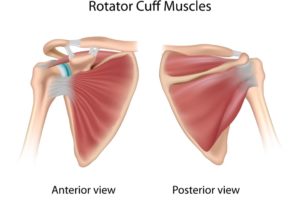What to Do When You’ve Injured Your Rotator Cuff

A rotator cuff injury is a common injury of the shoulder, but patients often misunderstand what the rotator cuff (RTC) is and does. Practicing in an outpatient orthopaedic clinic, physical therapists see many shoulder and upper extremity injuries involving the RTC. Often, our patients will come in stating they have pain in their shoulder, shoulder blade and arm. During the initial evaluation, doctors will tell their patients that they have a RTC injury. What does that mean? And more important, what should you do about it?
 The RTC is a set of four muscles that surround the shoulder joint; their job is to act as shunt muscles. This provides stability to the shoulder joint, and more importantly, allows the humeral head (upper portion of your arm) to stay centered on your glenoid fossa, the depression in your shoulder blade into which the humeral head fits. When there is injury, tear or overuse of these muscles, there will be changes in the joint motion as well as compensatory movements of surrounding joints.
The RTC is a set of four muscles that surround the shoulder joint; their job is to act as shunt muscles. This provides stability to the shoulder joint, and more importantly, allows the humeral head (upper portion of your arm) to stay centered on your glenoid fossa, the depression in your shoulder blade into which the humeral head fits. When there is injury, tear or overuse of these muscles, there will be changes in the joint motion as well as compensatory movements of surrounding joints.
Signs and Symptoms of RTC Injury/Tear
RTC injuries and tears can present differently for each patient. Often, patients will have an initial dull or achy pain in the shoulder and upper arm, which causes restrictions in their range of motion. If untreated, this pain can lead to compensatory movements of the surrounding joints and lead to further muscle inhibition and weakness. Patients may have pain in their neck, shoulder blade, and chest due to these compensatory movements; at this point, the dull or aching pain can become more intense and can be best described as a sharp pain.
Causes of Rotator Cuff Tear
There are two main causes for RTC tears: injury and degeneration. Injury (acute tears) is not preventable and usually occurs when falling on an outstretched arm, shoulder dislocations, or lifting objects that are too heavy using a jerking motion. Degenerative tears occur after repetitive stress to the muscle-tendon junction or tendon itself. These tears are very common as we age and are usually due to an imbalance in the shoulder girdle resulting in poor motion in the shoulder joint, therefore resulting in fraying of the tendon(s).
Options if You Suspect a RTC Tear
If you suspect you have a RTC injury or tear, you should first rest your shoulder. Avoid repetitive motions that reproduce pain (e.g. overhead reaching, reaching out to the side, behind your back). Schedule an appointment with your MD for an evaluation and diagnostic testing.
Conservative treatment will include possible anti-inflammatory medication (NSAIDs) and a course of physical therapy to restore kinematics of the shoulder, decrease pain and improve strength and regain function. If conservative treatment does not resolve your pain, patients can elect for surgical intervention. This has been done arthroscopically versus open repairs to the RTC. Following surgery, you will also have physical therapy to improve range of motion, decrease pain and improve strength and function.
If you are experiencing shoulder pain, request an appointment with one of our upper extremity specialists. Our shoulder and elbow experts will evaluate the cause of your shoulder pain and recommend a treatment plan that works for you.

